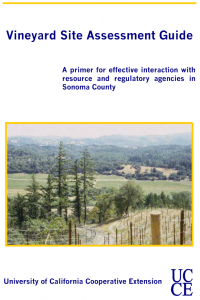 The Vineyard Site Assessment Guide for Sonoma County is a document offered by the University of California Cooperative Extension containing important information for prospective vineyard owners and developers. The guide is meant to inform any current or prospective landowners, realtors and vineyard developers of the various regulatory agencies and their requirements.
The Vineyard Site Assessment Guide for Sonoma County is a document offered by the University of California Cooperative Extension containing important information for prospective vineyard owners and developers. The guide is meant to inform any current or prospective landowners, realtors and vineyard developers of the various regulatory agencies and their requirements.
In addition to knowing the details of soil, climate and water availability, starting a vineyard requires extensive knowledge of the environmental laws and multiple ordinances that affect production and development. Proceeding with vineyard installation without knowing the facts concerning the requirements of federal, state and county natural resource regulatory agencies and ordinances can result in fines and more.
Aspects of a vineyard site that may trigger regulatory agency intervention include, but are not limited to, road development, vegetation conversion, and natural resources such as streams, rivers, slopes, river basins and tributary watersheds. The Vineyard Site Assessment Guide recommends using an appropriate USGS map, aerial photograph or lot line topographic map to identify specific areas of a site, and it features separate sections for information on each particular natural resource and vineyard characteristic.
The first step to using the guide is to carefully study the map or aerial photograph. Important aspects to note include the boundaries of the site of interest and the natural resources of the site. It is recommended that notes are made about the natural resources and the appropriate regulatory agencies to contact for clarification.
Once the maps and/or photographs have been assessed, and the appropriate notes made, the next step is to consult the Vineyard Site Assessment Guide itself for more information on the specific areas in need of further attention. These specific areas listed in the guide include:
- Driveway and Road System
- Neighbors
- Slope
- Soils
- Water Access and Rights
- Existing Erosion
- Vegetation
- Streams and Riparian Corridors
- Wet Areas
In each of the aforementioned sections are 4 subsections, including Significance, Regulations and Jurisdiction, Costs, and Next Steps.
The Significance subsection contains information on the specific section’s risks and benefits of water quality and drainage, habitats, and endangered or threatened vegetation types and species. Regulations and Jurisdiction lists the regulatory agency in charge of that specific section. These include the California Department of Water Resources Planning and Local Assistance Department, the California Regional Water Quality Control Board, the California Department of Forestry and Fire Protection, the United States Army Corps of Engineers, the National Marine Fisheries Service and the California Department of Fish and Game, and more. The Costs and Next Steps subsections include important information on application fees, filing fees, title search fees, permit fees and the remaining steps to take to complete the requirements of the each regulatory board or agency.
The guide is meant to be an educational tool. The Natural Resource Conservation Service Local Resource Conservation District and UC Cooperative Extension can offer additional information on the most critical areas of concern. However, these agencies do not regulate; it is only recommended to contact them to avoid common mistakes.
